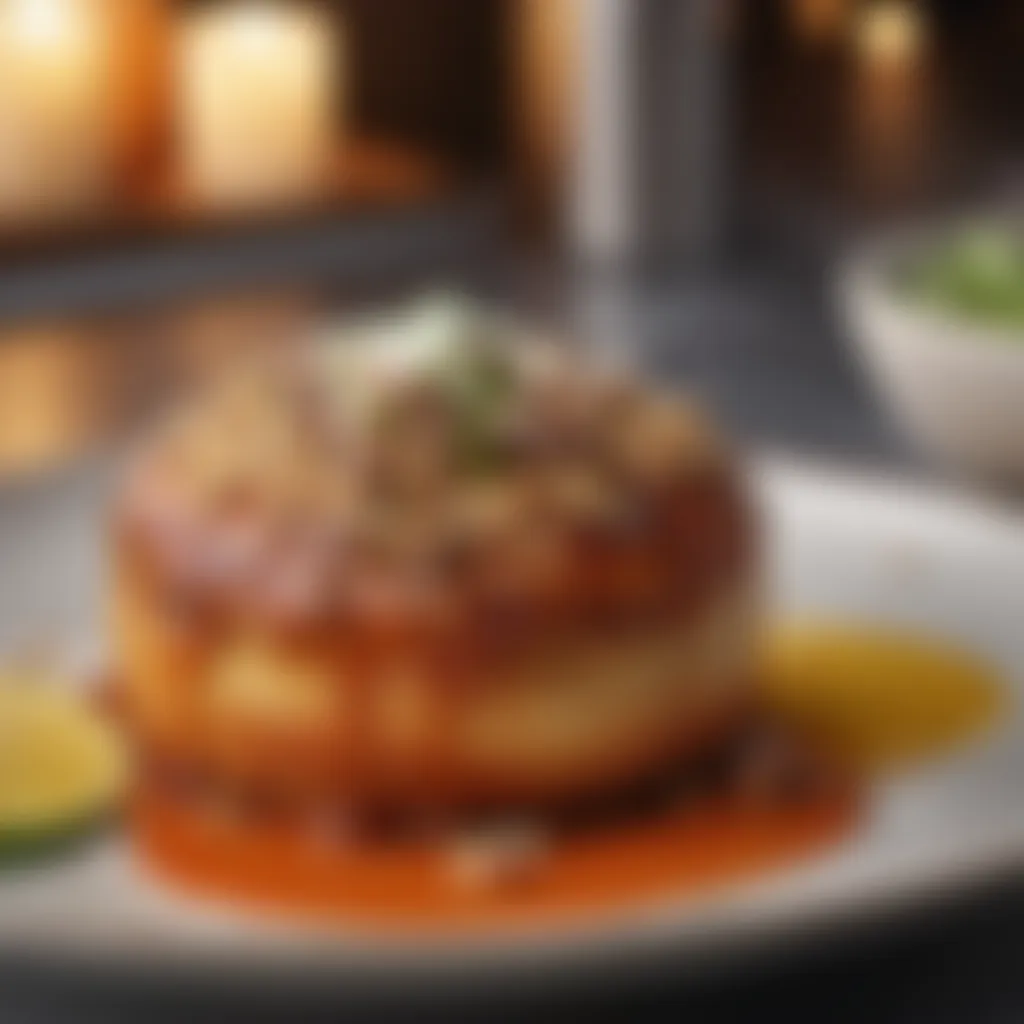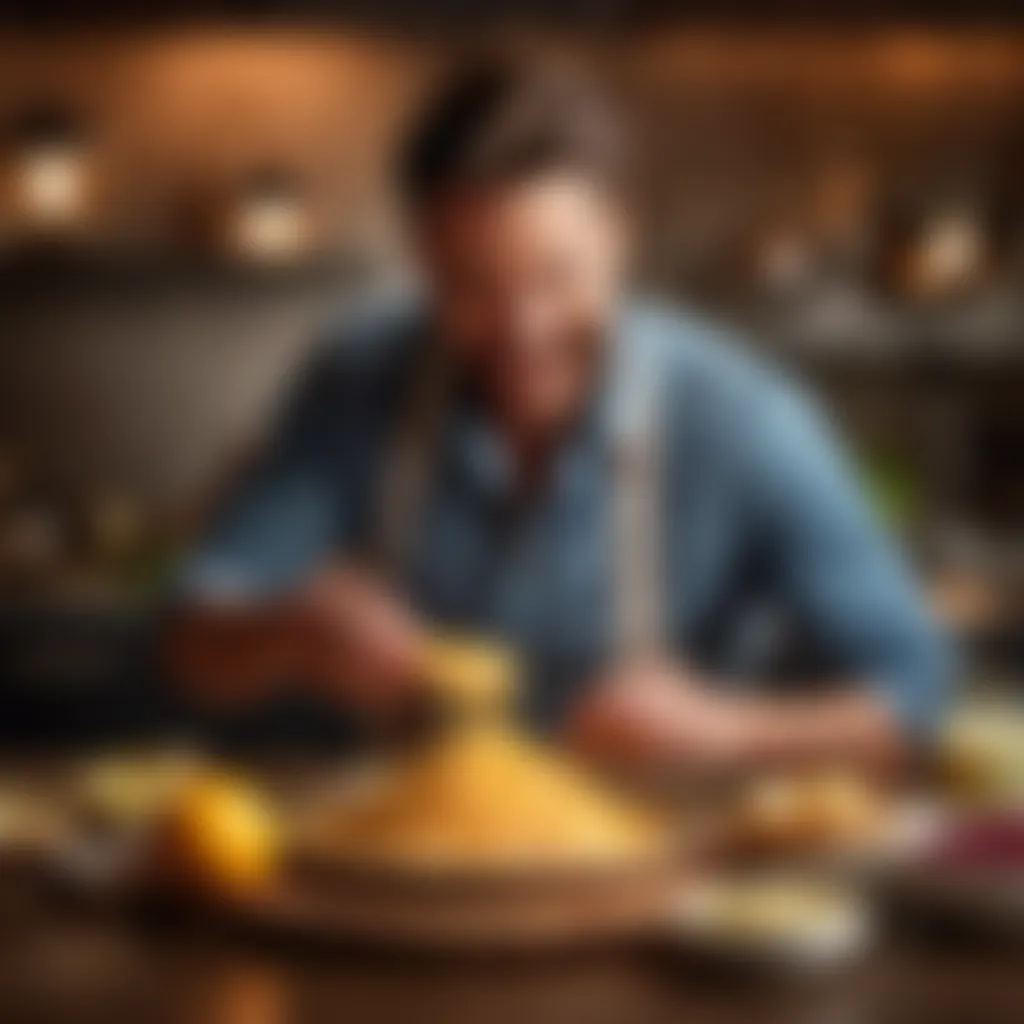Exploring Culinary Vocabulary: Synonyms for Recipes


Intro
In the realm of cooking, the words we choose can turn the mundane into something extraordinarily enticing. For culinary aficionados and casual cooks alike, a rich vocabulary not only aids in crafting delicious meals but also enhances the overall joy of sharing recipes. Each ingredient, technique, and flavor can be described in myriad ways, and learning these synonyms can truly broaden your culinary repertoire. Whether you're convincing someone to try a new dish or just adding flair to your own kitchen notes, word variety can transform your cooking communication.
Ingredients:
When embarking on any culinary adventure, the first step involves gathering a comprehensive list of ingredients. Below, a foundational recipe will serve as a template,
- 2 cups of all-purpose flour
- 1 teaspoon of baking powder
- 1/2 teaspoon of baking soda
- 1/4 teaspoon of salt
- 3/4 cup of sugar
- 1/3 cup of unsalted butter, softened
- 2 large eggs
- 1 teaspoon of vanilla extract
- 1 cup of milk
Preparation Steps:
Getting your ingredients right is just the beginning. The preparation is crucial, and here’s how you can go about it:
- Preheat your oven: Set your oven to 350°F (175°C). This is the golden temperature for many baking endeavors.
- Mix the dry ingredients: In a large bowl, whisk together the flour, baking powder, baking soda, and salt. This ensures all the leavening agents are evenly distributed.
- Cream the butter and sugar: In a separate bowl, beat the softened butter and sugar together until the mixture is light and fluffy. This incorporates air which contributes to the cake's texture.
- Add eggs: Add the eggs one at a time, mixing well after each addition. Introduce the vanilla extract at this point as well.
- Combine mixtures: Gradually add your dry mixture to the wet one, alternating with the milk. Start and end with the dry ingredients, mixing until just combined.
Technical Aspects:
Understanding the technicalities of your cooking is essential for achieving desired results. Pay attention to:
- Oven temperature: Always keep an eye on your oven temperature as it can fluctuate. Investing in an oven thermometer can ensure accuracy.
- Mixing time: Avoid over-mixing, particularly once the flour is added, as this can create a dense texture.
Cooking Process:
Now that you have your batter ready, it’s time for the main event:
- Prepare baking pan: Grease a round cake pan and line it with parchment paper for easy removal.
- Pour batter: Transfer your batter into the prepared pan, smoothing the top with a spatula.
- Bake: Place the pan in the preheated oven. Bake for about 30-35 minutes or until a toothpick inserted in the center comes out clean.
- Cool: Once baked, allow the cake to cool in the pan for 10 minutes before transferring it to a wire rack. This helps the cake retain moisture.
Troubleshooting Tips:
Even veteran cooks face challenges; here are some common pitfalls and their remedies:
- Cake sinking in the middle: This might be due to under-baking. Always rely on a toothpick test to check.
- Dry cake: If your cake turns out dry, consider adding a little milk or water in the batter, next time.
- Burned edges: If edges are overdone, try covering the cake with foil halfway through baking.
"A little bit of word-play can bring great flavor to even the simplest of recipes."
The language you use while cooking and describing your dishes can significantly impact your culinary journey. By experimenting with a variety of terms, you elevate not just recipes, but the entire cooking experience.
The Importance of Language in Culinary Arts
The interplay between language and the culinary arts is as intricate as the recipes that populate our kitchens. Words serve not only as guides to assembling ingredients but also as carriers of culture, tradition, and personal narrative. For those who find joy in cooking, understanding culinary vocabulary is not just beneficial—it's essential.
The significance of precise language in this realm cannot be overstated. Clear communication in cooking instructions plays a critical role in achieving desired results. For instance, terms like "fold" versus "stir" have very different implications in how a dish ultimately turns out; the first maintains airiness in baked goods, while the latter can lead to denser textures.
Additionally, culinary language enriches the experience of cooking, transforming each recipe into a story awaiting to be told. Just like a painter uses various colors to create a masterpiece, a cook uses a diverse lexicon to turn a simple list of ingredients into a well-defined dish. This can help elevate the act of cooking from a mundane task into a cherished experience.
"In the world of culinary arts, every word is a step towards not just nourishment, but also creativity and connection."
Effective culinary communication bolsters not only the understandings between the cook and the recipe but also connects friends and families during shared meals. Embracing a wider range of vocabulary can help foster deeper relationships through food. The ability to articulate ingredients or techniques boosts confidence and cultivates skill, enabling cooks—especially home cooks—to explore new horizons in the kitchen.
Furthermore, consideration of culinary terminology offers insight into the cultural contexts that shape our food. Different regions may adopt varied terms for the same technique or ingredient, enriching our overall culinary knowledge. Thus, language becomes not only a tool for cooking but also a means of cultural exchange. The world of culinary arts thrives when diverse terms are embraced and celebrated, leading to a shared understanding and appreciation of what we eat.
In summary, the importance of language in culinary arts extends far beyond mere instruction. It encompasses creativity, cultural exchange, and a means to elevate the cooking experience. By taking the time to understand and appreciate this diverse lexicon, we enhance not just our recipes but also the pleasure that comes from nurturing those we love.
A Closer Look at Recipe Terminology
Understanding the terminology used in cooking not just helps in following a recipe but also enhances the joy of creating and sharing culinary experiences. Recipes are like a language of their own; they tell a story about the ingredients, methods, and cultures behind the dishes we prepare. By taking a closer look at recipe terminology, one can appreciate the nuances that differentiate similar cooking methods, as well as the specific ingredients that make each dish unique.
Knowing the correct terms can significantly streamline the cooking process and can even result in better tasting dishes. Misunderstanding terms can lead to overcooked food or a lack of flavor. Therefore, precise language plays a critical role in ensuring that cooks, whether seasoned or novices, can replicate recipes successfully.
Defining Key Terms in Culinary Literature
When diving into the world of culinary arts, one often encounters various terms that may seem interchangeable. However, each term carries its own specific meaning and significance. For instance, the word "chop" can imply different techniques depending on the context, such as a rough chop versus a fine dice. These distinctions are crucial.
Here are a few key terms that form the backbone of culinary vocabulary:
- Mise en place: This French term means "everything in its place" and refers to the practice of preparing and organizing all ingredients before cooking.
- Al dente: An Italian phrase meaning "to the tooth"; it describes pasta that is cooked to be firm when bitten but not hard.
- Emulsify: This refers to the process of combining fats and liquids, like when making a vinaigrette by whisking oil and vinegar together.
"A recipe is a story that ends with a meal. Understanding the terms ensures the story unfolds correctly."
Understanding these fundamental terms is essential in elevating culinary skills and broadening one’s cooking horizon. This foundational knowledge not only aids in better comprehension of recipes but also invites creativity in experimenting with food.
The Evolution of Cooking Terminology
Culinary language is not static; it evolves just as cooking trends change. Throughout history, various influences have reshaped the linguistic landscape of recipes. Terms that were once prevalent become obsolete, while new ones emerge as cooking methods and ingredient availability fluctuate.


A brief exploration of how cooking terminology has evolved:
- Classic French Cuisine: Many cooking terms stem from French, as this style set a high standard for culinary arts. Terms like "sauté" and "julienne" originated from this influence and remain widely used today.
- Cultural Integrations: As globalization progressed, many cuisines blended. For instance, the introduction of words like "fusion cuisine" reflects this intermingling of culinary practices from different cultures.
- Health and Lifestyle Shifts: Modern dining has shifted towards healthier choices, introducing terminology like "gluten-free" and "keto" that influence how recipes are written and understood, catering to growing dietary preferences.
In essence, keeping up with the evolution of cooking terminology is paramount for anyone looking to consistently engage with culinary literature and recipes. This not only enriches the cooking experience but also bridges the gap between tradition and modernity in the kitchen.
Synonyms for Cooking Techniques
Understanding the linguistic diversity surrounding cooking techniques is essential for any recipe enthusiast. Not only does it enhance clarity in communication, but it also deepens one’s appreciation for the art of cooking. Synonyms for various techniques allow for creative expression in recipe writing. For instance, knowing when to use "blanch" versus "boil" can make a marked difference in culinary outcomes. This section will explore the nuances of different cooking methods through their synonyms, offering insights that may not be captured in standard cookbooks.
Boiling vs. Simmering
Both boiling and simmering involve heating water, but there is a subtle yet crucial distinction between the two. Boiling typically means cooking at high temperatures, around 100 degrees Celsius, leading to large bubbles breaking on the surface of the liquid. It's ideal for pasta or potatoes.
In contrast, simmering is the gentler sibling of boiling. Here, the liquid reaches a lower temperature—generally between 85 to 95 degrees Celsius. This technique allows flavors to meld whileprecisely avoiding the agitation that boiling brings. Think of simmering as the way to coax out deep flavors, especially in stocks or sauces, over a slower period.
Both methods have their place and understanding when to employ each can transform a dish from ordinary to extraordinaire.
Sautéing and Stir-Frying Explained
Sautéing and stir-frying might sound like interchangeable terms, but they have their own distinct characteristics that merit discussion. Sautéing refers to cooking food quickly in a small amount of fat over relatively high heat, typically in a pan. This method is commonly used for vegetables, allowing them to retain some crunch while developing flavor.
On the flip side, stir-frying originates from Asian cuisine and involves cooking food rapidly in a wok with a bit of oil. The key here is constant stirring, which ensures even cooking and prevents sticking. Think of stir-frying as a lively dance; ingredients are tossed and moved around, infusing with the heat while preserving their shape and texture.
Knowing these nuances can drastically impact the textures and flavors of your dishes, enriching your cooking vocabulary to communicate better with fellow culinary enthusiasts.
Baking, Roasting, and Their Varieties
When one thinks about baking, the mind often wanders to sweet treats like cakes and pastries. However, the term encompasses a broader spectrum, including breads and casseroles. Baking uses dry heat in an oven, resulting in complex chemical reactions that develop flavors and textures.
In contrast, roasting is often associated with meats and vegetables. While both methods use the oven, roasting tends to involve higher temperatures, often with fats that promote browning. This difference creates a delightful caramelization on the exterior. For instance, roasting a chicken can yield crispy skin while keeping the protein juicy—not something easily achieved through baking alone.
This section also introduces you to different variations within these methods, such as blind baking for pies or convection roasting, which employs fans for even heat distribution. Understanding these subtleties not only enhances the cooking process but also elevates your dish’s overall quality.
Grilling Techniques: Variations and Terms
Grilling can take many forms, but its essence lies in cooking food over direct heat. It's a popular method for outdoor barbecues but delves deeper than just cooking on a barbecue grill. Grilling allows for flavors to emerge through the caramelization of sugars and browning of proteins.
Then there’s indirect grilling, which involves placing food away from direct flames—ideal for larger cuts of meat. It allows slow cooking, whereby tough fibers soften without burning the outside. There’s also the technique of plank grilling, where food is cooked on a wooden plank. This method infuses dishes with subtle, smoky flavors not easily achieved through other grilling forms.
Lastly, the use of various grill types—like charcoal vs. gas—also plays a crucial role in the final flavor profile. Knowing which technique to use and how to articulate these methods makes for better communication and more enjoyable cooking experiences.
Epilogue
In summary, the lexicon surrounding cooking techniques enriches the culinary arts. By understanding the distinctions between boiling and simmering or sautéing and stir-frying, one can appreciate the delicacies of language in cooking. These nuanced terms not only improve recipe writing but also elevate the actual cooking experience, making it a more informed and satisfying process.
Ingredients: A Vocabulary Perspective
Ingredients are the backbone of any dish, acting as the building blocks upon which culinary creativity is built. When delving into the importance of ingredients, it's clear that understanding the vocabulary associated with them can significantly enhance the cooking experience. Utilizing a diverse lexicon regarding ingredients not only allows cooks to articulate their intentions more precisely but also opens up a world of possibilities in recipe development and flavor pairing. By exploring synonyms and related terms, home cooks can better convey the nuances of what they want to achieve in their meals.
Knowing the various terms for ingredients also fosters creativity in the kitchen. For instance, instead of simply saying "chicken," one might explore terms like "poultry" or specify the cut, such as "thighs" or "breasts." This depth of vocabulary can lead to new ideas in cooking strategies and presentation, enriching one's culinary repertoire. Whether a dish needs a dash of something special or a particular ingredient yields a preferred texture, the right words can guide home cooks to make informed decisions.
"A rich vocabulary in the kitchen is like having a well-stocked pantry; it allows for limitless creativity!"
Spices and Herbs: Expanding the Lexicon
When we think of spices and herbs, a whole universe of flavors comes to mind. They're the magic dust that can elevate a simple dish into something truly unforgettable. Understanding the distinctions between different spices and herbs can provide chefs with the tools they need to enhance flavor profiles effectively. A generic term such as "spice" does not do justice to the rich variety available; terms like "cumin," "paprika," or "saffron" evoke specific tastes, aromas, and cooking techniques.
- Cumin is often used in Indian and Middle Eastern cuisines, giving a warm, earthy tone to dishes.
- Paprika presents a variety of sweetness and bitterness, contributing color and subtle smoky flavors.
- Saffron, though pricey, transforms a meal with its distinct hue and sophisticated taste.
By expanding one's vocabulary around these ingredients, a chef can not only choose what to use but can also know when to substitute. Rather than saying, "add some spice," one might say, "add a pinch of cayenne for heat and a sprinkle of coriander for freshness," which is much more precise and effective.
Vegetables and Fruits: Diverse Terminology
In the world of vegetables and fruits, the right terminology holds the key to unlocking a multitude of flavors, textures, and nutritional profiles. From the depths of the earth to the sun-kissed branches, knowing the names and classifications of produce matters. Saying "vegetable" might suffice, but considering terms like "cruciferous" for broccoli or "nightshade" for tomatoes illuminates their unique characteristics and cooking methods.
Some examples to consider:
- Cruciferous (e.g., broccoli, cauliflower) can be healthful and add a satisfying crunch.
- Nightshades (e.g., tomatoes, eggplants) can introduce bold flavors and acidity.
- Leafy greens (e.g., spinach, kale) offer versatility.
Examining the distinctions in terminology allows a chef to tailor their cooking to diet preferences. Whether it's selecting a substitute for a specific vegetable or verifying the ripeness of a fruit, clarity in vocabulary can lead to better culinary outcomes.
Proteins: Various Forms and Descriptions
Protein is essential in any diet, but the diversity in how it can be described and understood is often underappreciated. Expanding vocabulary about proteins can guide home cooks in making informed choices about nutrition, preparation techniques, and pairings.
Rather than merely stating "meat," a clearer vocabulary can include descriptions such as "lean proteins like chicken breast" or "fatty fish like salmon." This also serves to highlight various cooking methods suitable for each. Understanding terms like "grass-fed" or "free-range" speaks to the quality and ethical considerations that may be important to some cooks.


- Lean proteins, such as turkey or fish, are great for healthy meals.
- Processed proteins, such as deli meats or sausages, can introduce convenience but often involve additives.
- Plant-based proteins, including beans and tofu, open the door to vegetarian and vegan options.
By deepening vocabulary around proteins, cooks can understand not only what they're preparing but also how it affects health and taste, leading to more mindful meal decisions.
Culinary Styles and Their Vocabulary
The realm of culinary styles forms a vibrant tapestry, reflecting cultures, traditions, and individual creativity. Understanding the vocabulary associated with these diverse culinary practices holds significance for recipe enthusiasts. It’s more than just words; it's about grasping the essence behind cooking techniques, the textures of food, and the artistry involved in meal preparation.
Different culinary styles lend unique flavors and twists to common ingredients. When someone refers to a dish as being prepared in a particular style—like Mediterranean or Creole—it instantly conjures an array of tastes and techniques associated with that region. This understanding allows cooks to make educated choices, whether that's selecting the right spice blend or using a specific method of preparation which can vastly alter a dish's outcome.
Incorporating a wide-ranging vocabulary not only elevates one’s cooking game, but also enhances communication with others in the kitchen. When discussing a ratatouille, for instance, knowing terms like "brunoise" or "mirepoix" can clarify recipes and improve the final result.
Exploring International Culinary Terms
The world is rich with culinary traditions, each boasting its own set of terms and practices. Understanding international culinary vocabulary gives cooks the tools to experiment and recreate diverse dishes.
For instance, in Italian cooking, the word "al dente" is often employed to describe pasta that is firm to the bite. This simple term embodies a fundamental aspect of Italian culture and cuisine, emphasizing texture and readiness. Knowledge of such terms enables home cooks to not only prepare foods correctly but also to embrace the culture behind it.
- Terms from Various Cuisines:
- Japanese: "Umami" – the savory flavor element.
- Indian: "Tadka" – tempering spices in oil.
- French: "Sous-vide" – a technique of cooking in vacuum-sealed bags at precise temperatures.
These terms serve as gateways to deeper culinary understanding and appreciation. When you infuse your cooking with international vocabulary, you nurture creativity and innovation in the kitchen.
Modernist Cuisine Language
Modernist cuisine is a contemporary culinary movement that incorporates advanced techniques and scientific principles to create stunning dishes. The language of modernist cuisine is rich with technical jargon that can be daunting but is essential for those looking to explore this innovative culinary field.
While traditional cooking relies on established methods passed down through generations, modernist cuisine thrives on experimentation. Terms like "spherification" or "emulsification" can sound intimidating, but they open a door to exciting possibilities in the kitchen. With spherification, for example, one can create spheres of fruit juice that burst in the mouth, adding an unexpected layer to a simple salad.
- Key Terms in Modernist Cuisine:
- "Foam": A technique to create an airy texture using a blender or siphon.
- "Molecular gastronomy": The application of scientific principles to cooking, often leading to unexpected flavor pairings.
- "Deconstruction": Breaking down traditional dishes into their components and reassembling them for a novel experience.
These terms signify a shift in how food is perceived, encouraging cooks to think outside the box. By embracing modernist vocabulary, home cooks can captivate guests and challenge their own culinary boundaries, ultimately merging science and art into a plate of food.
Nutritional Terminology in Recipes
Understanding nutritional terminology is key for anyone embarking on the culinary journey. In the context of recipe writing, it serves multiple purposes. Not only does it facilitate better comprehension of what one is consuming, but it also aids in making informed decisions about cooking methods and ingredient selection. When you know the definitions and implications of terms like "calories," "fiber," or "saturated fats," you elevate not just your cooking but also your overall approach to health and wellness.
When writing a recipe, including specific nutritional terms can help readers navigate their dietary preferences effectively. Imagine crafting a recipe for a light salad. Instead of merely listing the ingredients, you might emphasize its low calorie count and high fiber content, letting the audience know it’s an ideal choice for a filling yet guilt-free meal. This approach not only enriches understanding but also highlights the value of the dish.
Furthermore, various movements, such as plant-based eating or keto dieting, have formed around specific nutritional needs. Such terminologies give a clearer image of how a recipe fits into broader dietary patterns. This aspect is especially crucial for households where dietary restrictions are prevalent, as it ensures that every member can find something nutritious and satisfying.
"Knowing what’s in your food is not just a matter of wellness; it’s about empowerment in the kitchen."
Health-related Terminology
Diving deeper into health-related terminology, it becomes clear how crucial this subset of language is in the kitchen. On the surface, terms like "antioxidants," "gluten-free," or "low glycemic index" may seem just like trendy buzzwords. However, these descriptors provide essential insights that can transform a simple meal into a health-boosting powerhouse.
For instance, if a recipe proudly presents itself as rich in antioxidants—thanks to ingredients like blueberries or spinach—it not only speaks to flavor but also to wellness benefits. Similarly, noting a dish is gluten-free can open the door for those with celiac disease or gluten sensitivities, inviting them into a dining experience they might otherwise miss. Educating ourselves on these terms ensures we share our cooking in a more inclusive, savvy manner.
A good tip when considering health-related terminology is to avoid jargon. When writing your recipes, keep complex terms at bay unless absolutely necessary. Use descriptors that everyone can understand, thus avoiding alienation of any part of your audience.
Dietary Restrictions and Their Impact on Language
As our understanding of health and nutrition evolves, so does the language we use in recipe writing. Dietary restrictions impact not just individual choices but also the vocabulary we adopt in culinary discussions. Whether it’s veganism, paleo, or anyone with specific allergies, the language must reflect these nuances.
For example, if a recipe is designed without animal products, labeling it as "vegan" immediately clarifies its suitability for a large audience. This term carries weight and recognition, bridging a gap between food and lifestyle choices. Similarly, specifying that a dish is "nut-free" can save someone with allergies from a potential health risk.
Being aware of these dietary nuances not only makes your recipes more accommodating but also demonstrates respect for diverse eating habits. Make terms like "dairy-free" or "sugar-free" easily visible within your instructions to emphasize inclusivity.
The Role of Adjectives in Recipe Description
Adjectives play a crucial role in the world of culinary descriptions, imparting vivid imagery and enhanced meaning to recipes. They serve as the paintbrush that brings a dish to life in the reader's mind, allowing them to visualize not only what they will cook but also how it will taste and feel. Without this descriptive layer, recipes can often seem bland and uninspiring, potentially leading to underwhelming culinary experiences. By incorporating well-chosen adjectives, home cooks can set the stage for a meal that excites the palate and ignites the sense of smell.
Descriptive Terms That Elevate Recipes
Utilizing strong, evocative adjectives can transform an ordinary recipe into something extraordinary. For instance, consider a recipe that calls for "chicken breast." Now, if we spice it up to say, "succulent, herb-marinated chicken breast," right there, we have added depth to this simple phrase.
Additional examples that highlight the effectiveness of descriptive terms include:
- Golden-brown crusted bread instead of just bread
- Zesty, grilled shrimp rather than plain shrimp
- Velvety chocolate mousse for a basic mousse option
Each of these terms not only describes the food but also evokes feelings and anticipation, which can lead to a more enjoyable cooking experience. When describing a dish in a recipe, one could target the flavor, texture, aroma, or even the color. It’s these subtleties that capture the attention of the reader and may inspire them to try out the dish.
"Food is the most primitive form of comfort." - Sheilah Graham


Choosing the Right Adjectives for Appeal
Choosing the right adjectives isn't just a fluffing exercise; it requires consideration and skill. First, it’s important to think about the audience’s expectations. For a home cook, the terms should feel relatable and approachable. On the other hand, a gourmet audience might appreciate more refined or technical descriptors.
Some helpful guidelines to keep in mind when crafting your adjectives include:
- Be Specific: Instead of saying "spicy shrimp," opt for "fiery chili-infused shrimp."
- Consider the Senses: Does the dish smell sweet? Is it ever so slightly crunchy? Adjectives that appeal to the senses can enhance temptation.
- Culinary Attachments: If certain adjectives resonate culturally, like saying "soulful Southern gumbo" or "authentic Italian marinara," use those to connect with the audience.
Ultimately, the right adjectives can make a world of difference. They can elevate a humble recipe into a culinary masterpiece, ensuring the dish does not just end up on a plate but resides in the hearts and minds of those who partake in it.
Challenges in Culinary Language Precision
Language serves as the backbone of culinary creativity, shaping how we convey ideas and instructions about food. However, when it comes to culinary terminology, precision can sometimes get a bit muddled. The potential for misunderstanding and miscommunication can lead to culinary disasters or missed opportunities for deliciousness. It becomes essential for recipe enthusiasts to grasp the subtleties in language that can greatly affect the outcome of a dish. This section dives into the specific challenges posed by ambiguities in cooking terminology and regional variations in recipe language.
Ambiguities in Cooking Terms
Cooking terms often leave room for interpretation, which can create confusion. Take the term "crisp," for example. Does it refer to the texture, the color, or maybe both? When a recipe calls for something to be "crisped," the expectation can vary widely. For some, it might evoke a golden brown surface, while for others, it might suggest a specific texture that shatters upon bite.
This ambiguity extends to various techniques and ingredients. Terms like "chop," "dice," and "mince" can all carry different meanings depending on the context or the cook’s familiarity with them. Using the right term can be crucial in achieving desired results, and such inconsistencies lead to a lot of guesswork in the kitchen.
Furthermore, when sharing recipes online or within diverse groups, the lack of standardization can make it difficult for everyone to follow along. It’s not just an English concern either; translating culinary terms between languages often results in a loss of meaning.
"A well-chosen culinary term can mean the difference between a perfect dish and a culinary flop."
Regional Variations in Recipe Language
Food culture isn’t confined within borders; it flows across continents, bringing with it an array of regional terms that can vary immensely. For instance, a term like "soda" in one place may mean something entirely different in another. In the United States, it’s a fizzy drink, while in parts of England, it refers to a type of savory cake. This regional quirk can create hurdles for those striving to follow recipes from around the globe.
Say you come across a recipe that calls for "coriander"—in some regions, this might refer specifically to the seeds, while in others, it refers to the fresh leaves. Such discrepancies can lead to confusion not just in naming but in flavor profiles too. It’s not merely a semantics issue; the actual cooking experiences are shaped by these linguistic differences. Understanding such nuances is not only beneficial for the cook but is crucial to sharing culinary experiences authentically.
In summary, overcoming challenges of ambiguity and regional variation can empower recipe enthusiasts. With a solid grasp of diverse culinary language, cooks become more confident and precise, leading to better outcomes in their cooking endeavors. Understanding these elements is integral to truly appreciating the rich tapestry of culinary arts.
Resources for Expanding Culinary Vocabulary
Gaining a rich culinary vocabulary isn't just a nice-to-have; it's a game changer in the world of cooking. Expanding one's lexicon allows home cooks and food enthusiasts to express themselves more precisely. From understanding cooking techniques to selecting the correct ingredients, the words we use shape our culinary journey profoundly. In this section, we will dig into two key resources: digital and print dictionaries, as well as online communities. They both serve unique functions and cater to various learning styles.
Digital and Print Dictionaries for Chefs
When it comes to brushing up on culinary terminology, dictionaries are among the most stalwart tools at one’s disposal. Digital dictionaries, like Merriam-Webster’s online culinary glossary, offer instant access to definitions, synonyms, and even pronunciation. Print dictionaries, such as The Culinary Institute of America’s The Professional Chef, provide in-depth insights into culinary terms that digital formats might gloss over.
Using these resources can cultivate a better understanding of culinary language. Here are a few key elements to consider when using dictionaries for culinary studies:
- Accessibility: With online dictionaries, you can look up terms at the click of a button, making it easier to experiment with new vocab while cooking.
- Contextual Understanding: Print dictionaries often feature illustrations and detailed examples, which can clarify complex terms. For instance, when reading a recipe that mentions "julienne," a visual representation can make the method clearer.
- Depth of Knowledge: Established culinary dictionaries often explore the etymology of terms, offering broader cultural insights. This is especially useful when examining international dishes.
Dictionaries not only provide definitions but can also help deepen a recipe enthusiast's appreciation and reverence for the discipline of cooking.
Online Communities for Culinary Language Exchange
The Internet has effectively shrunk the globe, allowing for a multitude of culinary conversations to take place in real-time. Online communities like Reddit’s r/food or Facebook groups focused on culinary enthusiasts serve as platforms where individuals can exchange language and cooking experiences. These environments are ripe for discussion, enabling users to learn from one another in a way that books just can't match.
Here's a brief overview of why participating in these online spaces can be advantageous:
- Collaborative Learning: Engaging with others allows home cooks to share not just recipes, but the specific terms and techniques they associate with them. You may learn that what you call "braising" has a different term in another culture.
- Crowdsourced Knowledge: The collective expertise present in a community can validate or correct your understanding of culinary terms, providing a richer learning experience.
- Real-Time Feedback: Got a tough question regarding a technique? Posting it online can lead to quick responses and diverse perspectives from seasoned cooks.
When diving into online culinary communities, it's advisable to stay open-minded and curious. The varied experiences of different members allow for a fresher understanding of common and esoteric terms alike.
"Language in the kitchen is as essential as the ingredients themselves; choosing the right words can elevate your dish as much as a dash of fine salt."
With tools like dictionaries and online communities, recipe enthusiasts can greatly enhance their vocabulary. As you move forward in your culinary journey, consider these resources as integral part of your toolkit.
The Future of Culinary Terminology
The culinary landscape is always shifting, just like the flavors in a well-prepared dish. In our increasingly interconnected world, the terms and phrases we use in cooking are evolving. What was standard yesterday might not hold the same weight tomorrow. Embracing emerging language in recipes not only reflects contemporary cooking practices but also influences how home cooks engage with their culinary adventures. This shift is pivotal for recipe enthusiasts who thrive on understanding the nuances in culinary language.
The importance of keeping pace with these changes cannot be overstated. By understanding the future of culinary terminology, recipe enthusiasts can better navigate an evolving kitchen landscape. Knowing contemporary jargon enhances communication among cooks and brings clarity to the kitchen, making it easier to share and follow recipes. It also fosters creativity; when one understands different ways to describe a cooking process, it can spark new ideas in the kitchen.
Emerging Trends in Cooking Language
Language in the culinary world is experiencing a renaissance influenced by globalization and digital innovation. One significant trend is the rise of fusion cuisine, which blends elements from multiple culinary traditions. This blending is not just about flavors; it’s also about vocabulary. Terms are borrowed and adapted across cultures, creating a rich tapestry of cooking language. Take the term "taco" for example; it originates from Mexican cuisine, yet its usage has spread across various culinary contexts, from gourmet interpretations to everyday home cooking.
Not only are we witnessing the adoption of terms from various cuisines, but also the emergence of new cooking practices that require fresh language. For instance, concepts like "meal prep" and "slow cooking" have gained traction, shaping how recipes are described and understood. This evolution extends to ingredient descriptions and methods, where words like "sous-vide" and "deconstructing" can elevate a simple recipe into an avant-garde culinary creation.
"Language is the essence of culinary communication; without it, the art of cooking becomes a silent and isolated endeavor."
Impact of Social Media on Culinary Language Use
Social media platforms have undeniably reshaped how we connect and share culinary knowledge. No longer confined to recipe books or culinary schools, cooking knowledge spreads at lightning speed across platforms like Instagram and TikTok. This digital revolution has birthed a new culinary lexicon that reflects our modern food landscape. Through hashtags like #foodporn or #instafood, home cooks are inspired not just by recipes but also by the contemporary language that flows with them.
In addition, trends in visual storytelling have transformed how recipes are presented. The rise of video content means that precise terminology needs to be accessible and digestible. Short, snappy phrases often replace longer descriptions, tailored for a more casual audience. This trend is particularly engaging to younger cooks who prefer quick information at their fingertips rather than lengthy instructions.
Moreover, social media creates a platform for cultural exchange, allowing individuals from diverse backgrounds to share culinary experiences. This cross-pollination of ideas not only introduces new flavors and techniques but also enriches our vocabulary, making the language of cooking more dynamic. For instance, terms like "umami" are now part of common vernacular, illustrating just how a single word can enhance understanding and appreciation of complex flavors.
As a result, recipe enthusiasts who engage with these platforms and trends can stay ahead of the culinary curve, embracing a vocabulary that continually shifts and evolves.







